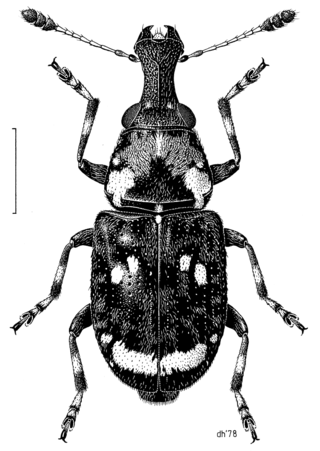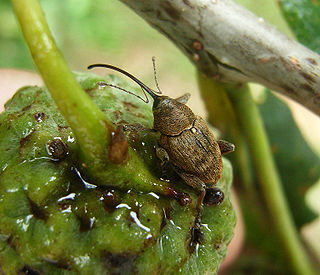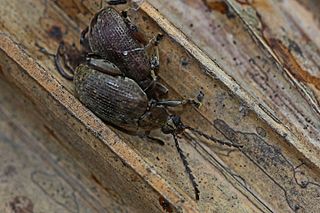
Centaurea is a genus of over 700 species of herbaceous thistle-like flowering plants in the family Asteraceae. Members of the genus are found only north of the equator, mostly in the Eastern Hemisphere; the Middle East and surrounding regions are particularly species-rich. In the western United States, yellow starthistles are an invasive species. Around the year 1850, seeds from the plant had arrived to the state of California. It is believed that those seeds came from South America.

Weevils are beetles belonging to the superfamily Curculionoidea, known for their elongated snouts. They are usually small – less than 6 mm in length – and herbivorous. Approximately 97,000 species of weevils are known. They belong to several families, with most of them in the family Curculionidae. It also includes bark beetles, which while morphologically dissimilar to other weevils in lacking the distinctive snout, is a subfamily of Curculionidae. Some other beetles, although not closely related, bear the name "weevil", such as the biscuit weevil, which belongs to the family Ptinidae.

Alliaria petiolata, or garlic mustard, is a biennial flowering plant in the mustard family (Brassicaceae). It is native to Europe, western and central Asia, north-western Africa, Morocco, Iberia and the British Isles, north to northern Scandinavia, and east to northern Pakistan and Xinjiang in western China.

The bean weevils or seed beetles are a subfamily (Bruchinae) of beetles, now placed in the family Chrysomelidae, though they have historically been treated as a separate family. They are granivores, and typically infest various kinds of seeds or beans, living most of their lives inside a single seed. The subfamily includes about 1,650 species and are found worldwide.

Sitophilus is a genus of weevils in the tribe Litosomini. Some species are familiar as pests of stored grain, nut, or seed. Notable pest species include the rice weevil, wheat weevil, and maize weevil.

Chamaerops is a genus of flowering plants in the family Arecaceae. It contains only one species, Chamaerops humilis, variously called European fan palm or the Mediterranean dwarf palm. It is one of the most cold-hardy palms and is used in landscaping in temperate climates.

Ulex europaeus, the gorse, common gorse, furze or whin, is a species of flowering plant in the family Fabaceae, native to the British Isles and Western Europe.

Brentidae, sometimes known as the primitive weevils, is a cosmopolitan family of primarily xylophagous beetles also known as straight-snouted weevils. The concept of this family has been expanded with the inclusion of three groups formerly placed in the Curculionidae; the subfamilies Apioninae, Cyladinae, and Nanophyinae, as well as the Ithycerinae, previously considered a separate family. They are most diverse in the tropics, but occur throughout the temperate regions of the world. They are among the families of weevils that have non-elbowed antennae, and tend to be elongate and flattened, though there are numerous exceptions.

Anthribidae is a family of beetles also known as fungus weevils. The antennae are not elbowed, may occasionally be longer than the body and thread-like, and can be the longest of any members of Curculionoidea. As in the Nemonychidae, the labrum appears as a separate segment to the clypeus, and the maxillary palps are long and projecting.

Curculio is a genus of weevils belonging the family Curculionidae and subfamily Curculioninae. Members of the genus are commonly referred to as acorn weevils or nut weevils as they infest the seeds of trees such as oaks and hickories. The adult female weevil bores a tiny hole in the immature nut to lay her eggs, which then hatch into legless grubs. In autumn, the grubs bore holes through the shells from the inside to emerge into the soil where they may live for a year or two before maturing into adults.

Curculio glandium, is a species of European carpophagus weevil in the genus Curculio, the acorn and nut weevils. It eats by a rostrum, an elongated snout, that is used for piercing.

Larinus is a genus of true weevils, comprising about 180 species, mostly in the Palaearctic region. Turkey appears to have a significant diversity of the group, with more than 50 species recorded in the Eastern part of the country.

Rhinocyllus conicus is a species of true weevil. It is best known as a controversial agent of biological pest control which has been used against noxious thistles in the genera Carduus, Cirsium, Onopordum, and Silybum.

Caryobruchus gleditsiae is a species of beetle in the family Chrysomelidae. It lives in North and Central America and develops inside the seeds of palm trees. Adults grow to a maximum length of 11 mm (0.43 in), the size depending on the size of the seed it grew up in. The species was first described by Carl Linnaeus in his 1763 Centuria Insectorum.

Rhynchophorus, or common name palm weevils, is a genus of beetles in the weevil family, Curculionidae. Palm weevils are major pests of various trees in the family Arecaceae throughout the tropics including: coconut, Areca catechu, species of the genus Phoenix, and Metroxylon sagu. Two species are invasive pests outside their native ranges, Rhynchophorus ferrugineus and Rhynchophorus palmarum.

Bruchidius is a genus of beetles in the bean weevil subfamily (Bruchinae) of the leaf beetle family, Chrysomelidae. Most are native to the Old World.

Bruchus is a genus of beetles in the leaf beetle family, Chrysomelidae. They are distributed mainly in the Palearctic, especially in Europe. Several occur in other parts of the world, such as North America, Africa, and Australia, as introduced species. Several species are notorious agricultural pests.

Acanthoscelides obtectus, the bean weevil, is a species of bruchid beetle. The species was described in 1831 by Thomas Say.

Bruchus pisorum, known generally as pea weevil, is a species of leaf beetle in the family Chrysomelidae. Other common names include the pea beetle and pea seed beetle. It is found in Europe and Northern Asia, North America, and temperate Asia.



















